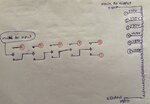swapan
Full Member level 4
Hi irfan ahmad,
It is desirable to actuate electromagnetic relay near current zero crossing. If a voltage zero crossing detector is included and interfaced to any port, how you will manage it in code. To be more clear - how much delay would be required to send a drive for relay after detecting voltage zero crossing.
swapan
It is desirable to actuate electromagnetic relay near current zero crossing. If a voltage zero crossing detector is included and interfaced to any port, how you will manage it in code. To be more clear - how much delay would be required to send a drive for relay after detecting voltage zero crossing.
swapan
